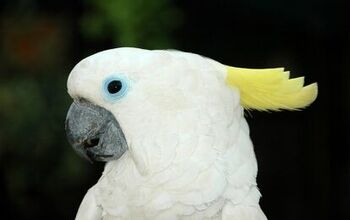Bare Eyed Cockatoo


About Bare Eyed Cockatoo
The Bare Eyed cockatoos, also known as little corellas, are one of the smaller and unique breeds in the cockatoo family. They stand out with some of their peculiar details but share many similarities with their close cousins as well. With their silly personality and an affectionate, loving side, they have quickly become one of the most popular pet parrots in Australia and the rest of the world as well. But, as it’s often said, cockatoos, in general, might not be the pet for everyone. So let’s get to know the little corellas and what makes them so popular!
Bare Eyed Cockatoos stand out with their peculiar looks and distinct traits and are loved worldwide.
Native Region/Natural Habitat
Little corellas are some of the most common and widespread parrots in Australia as their native habitat stretches over most of the continent. They are also found in New Guinea. These birds prefer to live in the coastal plains, the arid and dry central Australian deserts, and urban areas as well. Little corellas adapted to live in urban areas and are now a common sight in Sydney, Brisbane, and Canberra. Throughout the history, these cockatoos have been a part of the Aboriginal culture. These tribes would keep them as pets, as well as hunt them for food and headgear decoration.
Although considered one of the smaller cockatoo breeds, the Bare Eyed Cockatoo is medium to large-sized when compared to other parrots. The adults reach an average length of 14 to 16 inches (35 to 40 centimeters) and can weigh up to 1 pound (500 grams). They also have an impressive wingspan, too, so ensure a roomy cage and plenty of free space. These cockatoos are zygodactyls – they have a distinct ability to use their feet as a helping tool when climbing, eating and hanging upside down.
When it comes to sounds and noise level, there’s one thing you need to remember about all cockatoos – they can be very loud. While this is absolutely true for large cockatoos, the little corellas are slightly less talkative in comparison. They have a good ability to memorize in repeat common words, and mostly in a clear, well-defined voice. But still, there is the tendency to mimic human speech in their loud, slurred and incredibly silly manner, which can go on for a while and cause some tension. Bare Eyed Cockatoo might not be the best apartment bird.
Bare eyed cockatoos are entirely white. While this goes for many common cockatoo breeds, a few details are certainly unique. And that’s the trait that gives them their name – a patch of featherless light blue skin around the eyes and the upper cheek, with slight pink coloration close to the beak. They also have their popular crest, which is used to signify their mood and alertness. Don’t confuse the simplicity of their appearance for plainness – these are graceful birds with a beautiful plumage.
The bare patch around the eyes is the defining detail of the Bare Eyed Cockatoo. The rest is shared with their close cousins.
In the wild, little corellas are mostly ground feeders but sometimes eat in the trees and shrubbery. They like seeds, insects, fruits, and nectar. They also intrude on agricultural crops where they eat wheat, corn, and barley. As a pet, they will love a seed based mixed designed for cockatoos. But still, you’ll need to balance this diet with a regular addition of fresh fruits and vegetables. Apples, bananas, oranges, cabbage, kale, and carrots are some of their favorite treats.
Bare Eyed Cockatoo is really good at adapting to most conditions, thanks to its harsh native habitat and a strong, robust build. They have a long lifespan – up to 60 years – and will rarely get sick if given enough attention and good care. Some common symptoms of sickness are feather plucking, apathy, difficulty breathing and loss of appetite. One thing they absolutely love is bathing. Bathing dishes and shower time should be a regular treat, as it helps maintain a good health base.
Showers are a treat for little corellas. They are refreshing, cool them down, and keep skin diseases at bay.
Bare Eyed Cockatoo parrots are very intelligent and highly energetic birds. Getting one as your pet demands a lifelong commitment and a lot of care. They love to hang upside down, to nibble on things and generally exercise their strong beaks. Their mood can also revolve around two patterns: it’s either all fun, games and noisy silliness or quiet and cuddly affectionate time. Just keep in mind – with a bit of patience and dedicated care, a cockatoo can and will become a loving friend for a long, long time.
Photo credit: Martin Pelanek/Shutterstock; John Carnemolla/Shutterstock

A proud mama to seven dogs and ten cats, Angela spends her days writing for her fellow pet parents and pampering her furballs, all of whom are rescues. When she's not gushing over her adorable cats or playing with her dogs, she can be found curled up with a good fantasy book.
More by Angela Vuckovic

























